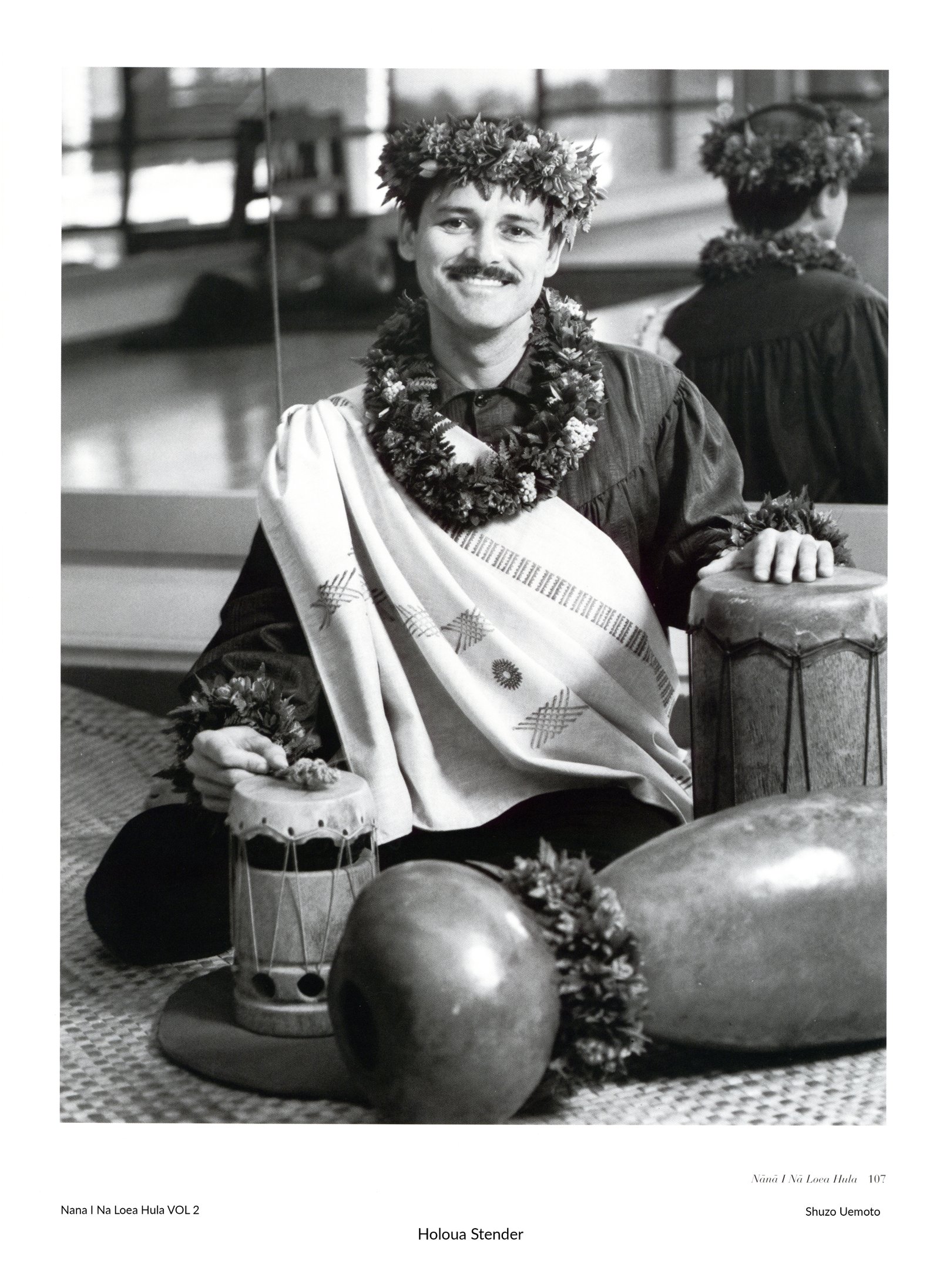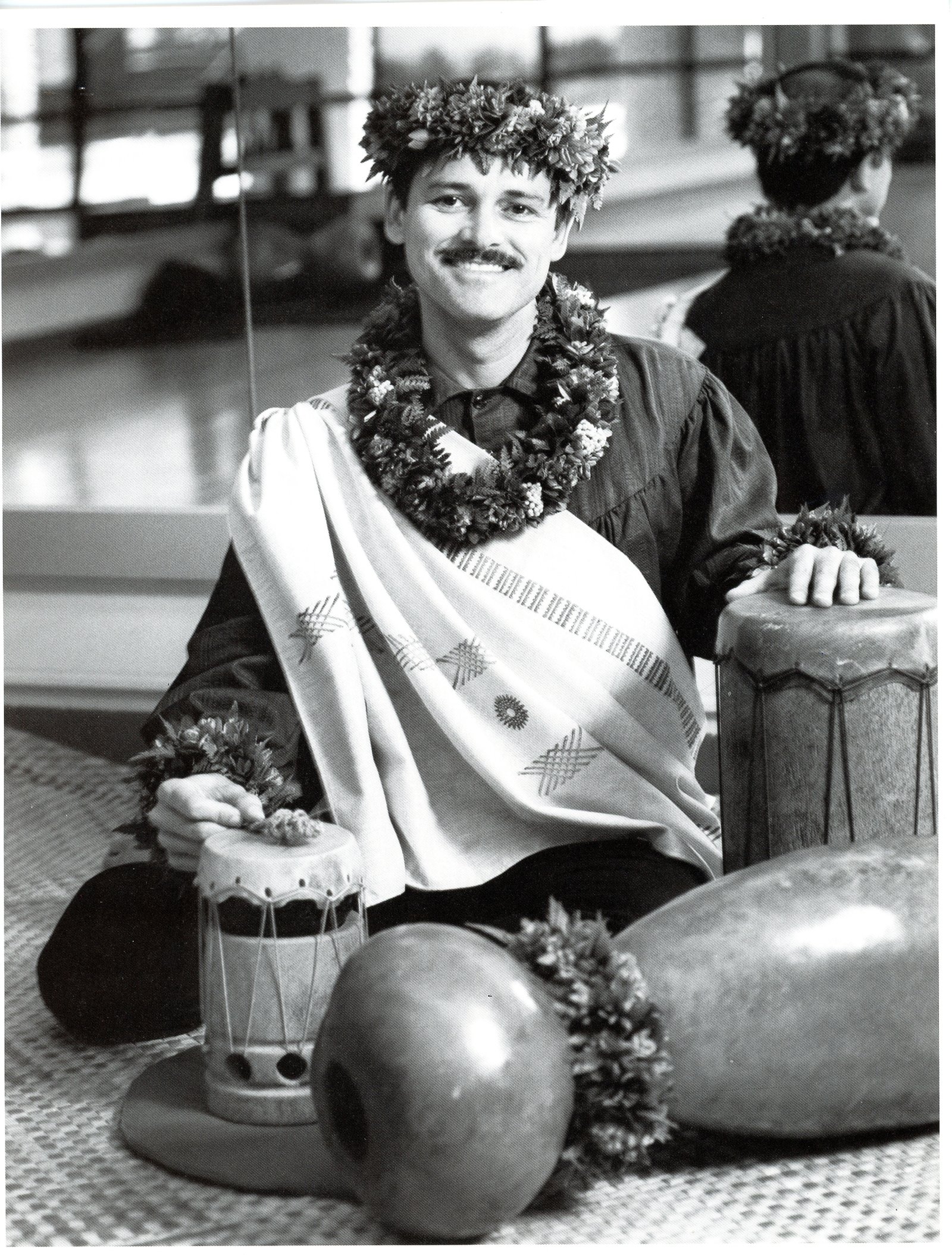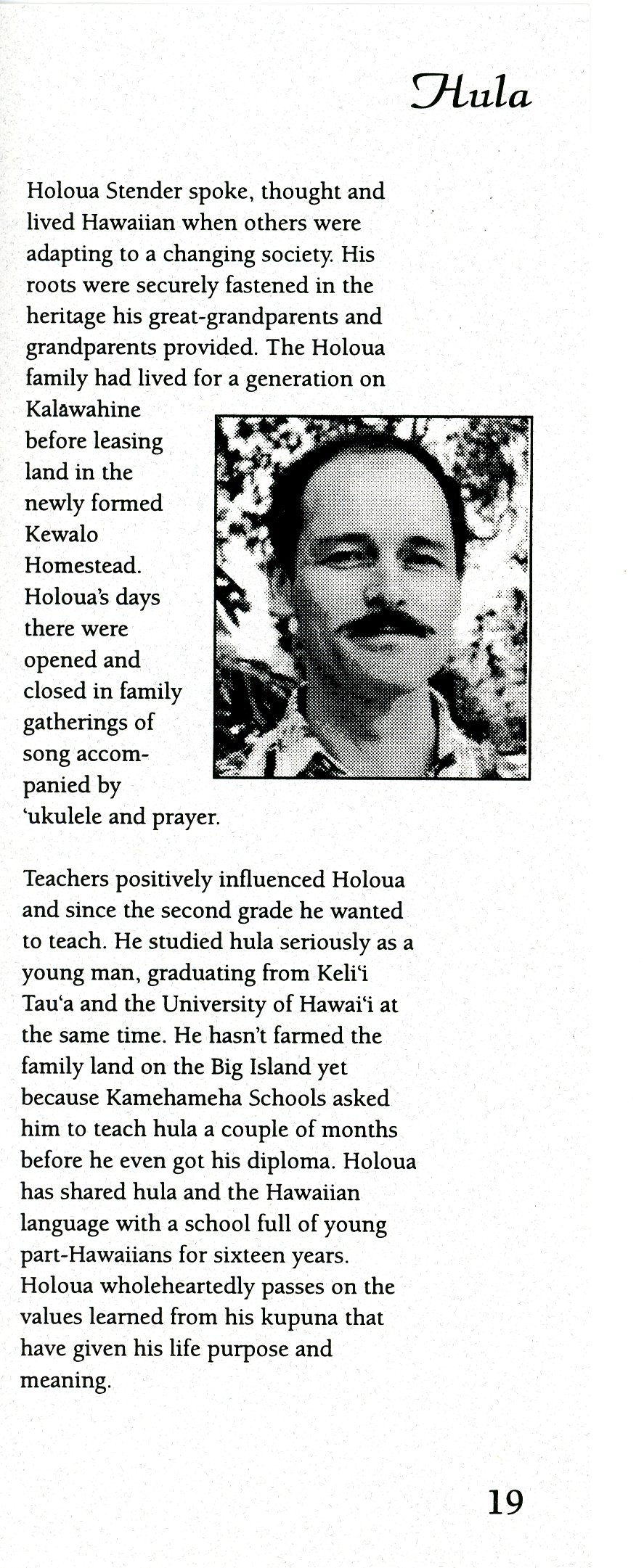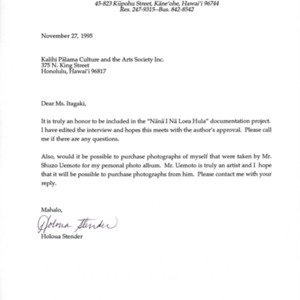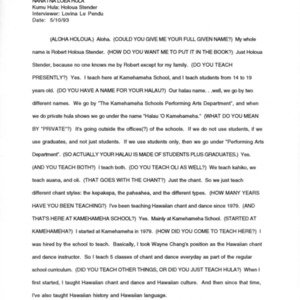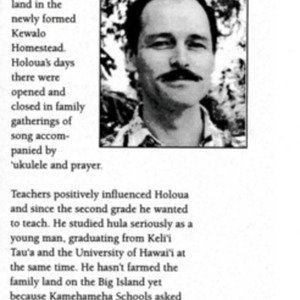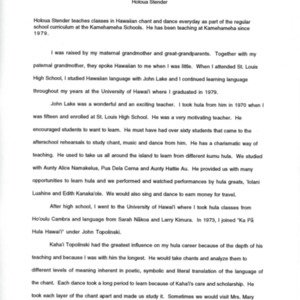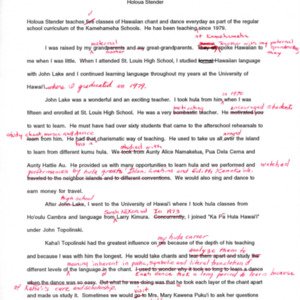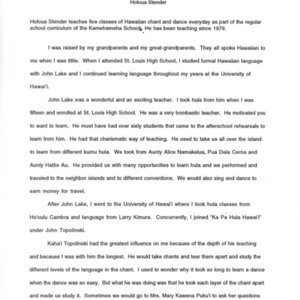Holoua Stender
Title
Holoua Stender
Subject
Nā Kumu Hula Holoua Stender - Nānā I Nā Loea Hula Volume 2 Page 106
Description
Holoua Stender has been teaching Hawaiian chant and dance classes as part of the regular curriculum at the Kamehameha Schools since 1979.
I was raised by my maternal grandmother and great-grandparents. Together with my paternal grandmother, they spoke Hawaiian to me when I was little. When I attended St. Louis High School, I studied Hawaiian language with John Lake and I continued learning the language throughout my years at the University of Hawaiʻi where I graduated in 1979.
I took hula from John Lake in 1970 when I was fifteen. He was a wonderful and exciting teacher. He motivated the students to want to learn. He must have had over sixty students who came to the after school rehearsals to study chant, music, and dance from him. He had a charismatic way of teaching. He used to take us all around the island to learn from different kumu hula. We studied with Aunty Alice Nāmakelua, Pua Dela Cerna and Aunty Hattie Au. He provided us with many opportunities to learn hula and we performed and watched performances by hula greats such as ʻIolani Luahine and Edith Kanakaʻole.
After high school I went to the University of Hawai‘i where I took hula classes from Hoʻoulu Cambra and language from Sarah Nakoa and Larry Kimura. In 1973 I joined Ka Pā Hula Hawaiʻi under John Kaha‘i Topolinski. Kaha‘i had the greatest influence on my hula career because of the depth of his teaching and because I was with him the longest. He would take chants and break them down to reveal the different levels of meaning inherent in the language of the chant. Each dance took a long period to learn because of Kaha‘i’s care and scholarship. Sometimes we would visit Mrs. Mary Kawena Pukui to ask her questions about different chants and she would unravel the hidden intricacies of the language.
In 1977 1 left Kaha‘i and went to learn from Darrell Lupenui. Darrell was a very loving person. I have special memories of him and the way he taught. He would sit on the floor and he would teach us by describing the motions to us. He wouldn’t perform the motion but he would tell us what to do and the dances would become so perfect and beautiful. He hardly ever changed things. He had a mental picture of the dance in his head and he described and translated his mental images to teach us. It’s like someone who is a genius at creating music. They create the music in their heads. He would explain it to the alakaʻi and they would then show us the motion. Darrell Lupenui was an artist and perhaps a genius in hula. He worked within the parameters of hula and he created art right inside his head.
When Keliʻi Tau‘ā asked me to join his kumu hula class, Darrell was very gracious and released me to go with Keli‘i. My entire two years with Keli‘i was spent training for graduation. Part of our training for graduation was to compose mele. Keliʻi invited Manuel Silva, Henry Pa, Kalena Silva, and other renown kumu hula to witness our graduation. They came to watch and comment on our choreography and our compositions. We performed at the Star of the Sea on the evening following our formal graduation ‘ūniki ceremony held at Sand Island. Charles Ka‘upu and I were fortunate to have graduated as kumu hula by Keliʻi Tauʻā in 1979.
I teach Hawaiian chant and dance at the Kamehameha Schools. Randie Fong and Wayne Chang work closely with me to create special dance productions for the school. Three hundred students show up for our auditions and we’ll select maybe forty or fifty of the most talented young men and women. They must demonstrate exemplary skills in music and dance.
We teach our students, “‘A‘ohe pau ka ‘ike i kāu hālau,” which means, “all knowledge is not found under one roof.” We ask students not to change or forget what was taught to them by other kumu hula. We try as much as possible to teach them a new style and enhance their dancing causing them to strive for greater personal achievement. We are fortunate that most students come to us with experience and we don’t want to dampen that experience. We want to give them another hula challenge and teach them to excel in performance.
Students begin class outside on the lānai. They line up at a designated time to chant their oli kāhea. If we feel that the chant is sincere, they will be welcomed inside. At times they may continue chanting for twenty minutes to half an hour. When they walk in, it’s perfectly quiet. We practice the basic steps for anywhere from twenty minutes to an hour. After the basics we break up into three groups and each kumu will teach a different dance.
I studied hula because of language. I could see the beauty of the poetry and beauty of the Hawaiian language through dance and chant. That’s what made me interested in hula because hula demonstrates the beautiful soul of the Hawaiian language.
106 Holoua Stender
I was raised by my maternal grandmother and great-grandparents. Together with my paternal grandmother, they spoke Hawaiian to me when I was little. When I attended St. Louis High School, I studied Hawaiian language with John Lake and I continued learning the language throughout my years at the University of Hawaiʻi where I graduated in 1979.
I took hula from John Lake in 1970 when I was fifteen. He was a wonderful and exciting teacher. He motivated the students to want to learn. He must have had over sixty students who came to the after school rehearsals to study chant, music, and dance from him. He had a charismatic way of teaching. He used to take us all around the island to learn from different kumu hula. We studied with Aunty Alice Nāmakelua, Pua Dela Cerna and Aunty Hattie Au. He provided us with many opportunities to learn hula and we performed and watched performances by hula greats such as ʻIolani Luahine and Edith Kanakaʻole.
After high school I went to the University of Hawai‘i where I took hula classes from Hoʻoulu Cambra and language from Sarah Nakoa and Larry Kimura. In 1973 I joined Ka Pā Hula Hawaiʻi under John Kaha‘i Topolinski. Kaha‘i had the greatest influence on my hula career because of the depth of his teaching and because I was with him the longest. He would take chants and break them down to reveal the different levels of meaning inherent in the language of the chant. Each dance took a long period to learn because of Kaha‘i’s care and scholarship. Sometimes we would visit Mrs. Mary Kawena Pukui to ask her questions about different chants and she would unravel the hidden intricacies of the language.
In 1977 1 left Kaha‘i and went to learn from Darrell Lupenui. Darrell was a very loving person. I have special memories of him and the way he taught. He would sit on the floor and he would teach us by describing the motions to us. He wouldn’t perform the motion but he would tell us what to do and the dances would become so perfect and beautiful. He hardly ever changed things. He had a mental picture of the dance in his head and he described and translated his mental images to teach us. It’s like someone who is a genius at creating music. They create the music in their heads. He would explain it to the alakaʻi and they would then show us the motion. Darrell Lupenui was an artist and perhaps a genius in hula. He worked within the parameters of hula and he created art right inside his head.
When Keliʻi Tau‘ā asked me to join his kumu hula class, Darrell was very gracious and released me to go with Keli‘i. My entire two years with Keli‘i was spent training for graduation. Part of our training for graduation was to compose mele. Keliʻi invited Manuel Silva, Henry Pa, Kalena Silva, and other renown kumu hula to witness our graduation. They came to watch and comment on our choreography and our compositions. We performed at the Star of the Sea on the evening following our formal graduation ‘ūniki ceremony held at Sand Island. Charles Ka‘upu and I were fortunate to have graduated as kumu hula by Keliʻi Tauʻā in 1979.
I teach Hawaiian chant and dance at the Kamehameha Schools. Randie Fong and Wayne Chang work closely with me to create special dance productions for the school. Three hundred students show up for our auditions and we’ll select maybe forty or fifty of the most talented young men and women. They must demonstrate exemplary skills in music and dance.
We teach our students, “‘A‘ohe pau ka ‘ike i kāu hālau,” which means, “all knowledge is not found under one roof.” We ask students not to change or forget what was taught to them by other kumu hula. We try as much as possible to teach them a new style and enhance their dancing causing them to strive for greater personal achievement. We are fortunate that most students come to us with experience and we don’t want to dampen that experience. We want to give them another hula challenge and teach them to excel in performance.
Students begin class outside on the lānai. They line up at a designated time to chant their oli kāhea. If we feel that the chant is sincere, they will be welcomed inside. At times they may continue chanting for twenty minutes to half an hour. When they walk in, it’s perfectly quiet. We practice the basic steps for anywhere from twenty minutes to an hour. After the basics we break up into three groups and each kumu will teach a different dance.
I studied hula because of language. I could see the beauty of the poetry and beauty of the Hawaiian language through dance and chant. That’s what made me interested in hula because hula demonstrates the beautiful soul of the Hawaiian language.
106 Holoua Stender
Citation
“Holoua Stender,” Nā Kumu Hula Archive, accessed September 16, 2025, https://nakumuhula.org/archive/items/show/151.
